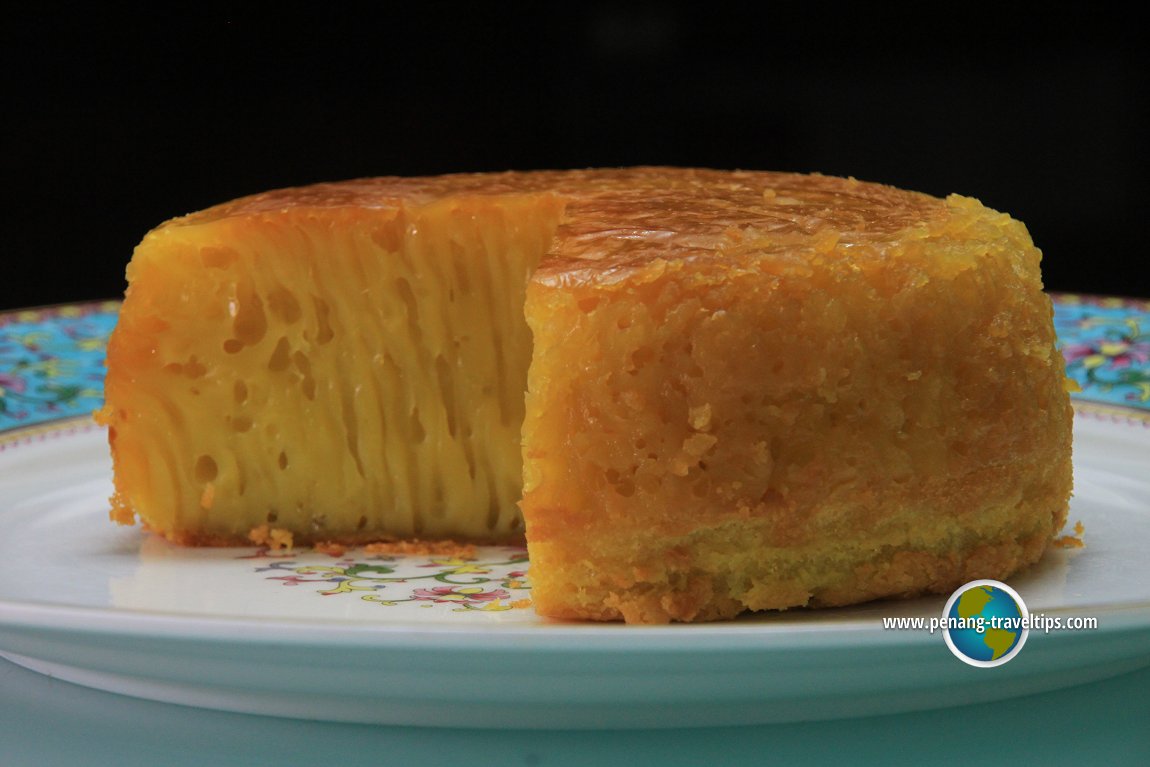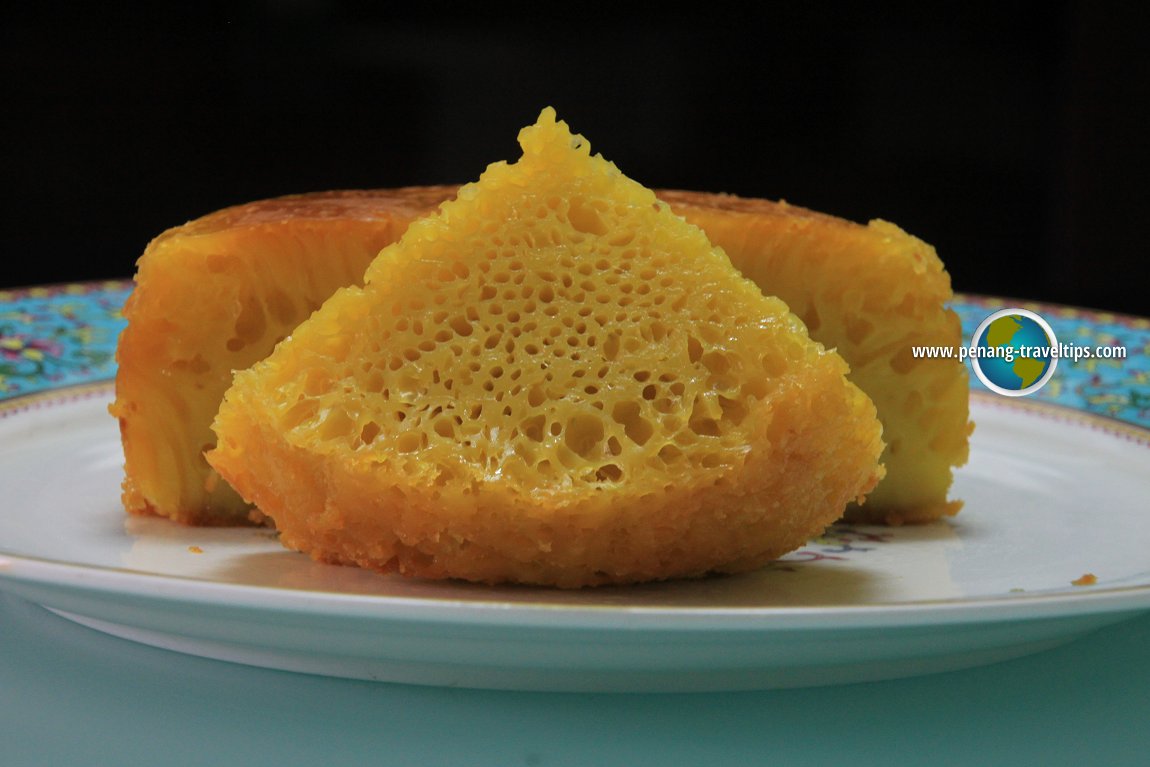 Bika Ambon slice (12 July 2014)
Bika Ambon slice (12 July 2014)
Bika Ambon
 is an Indonesian kuih that is most popular in Medan. Although it is technically not a Penang kuih, it is still popular in Penang, especially among the Baba Nyonya people, as we have often have relatives in Medan. The bika ambon is made using eggs, tapioca starch, coconut milk, sugar, yeast, salt, yellow coloring and pandan juice. The signature characteristic of bika ambon are the spongy "bee hive" texture created by the yeast.
is an Indonesian kuih that is most popular in Medan. Although it is technically not a Penang kuih, it is still popular in Penang, especially among the Baba Nyonya people, as we have often have relatives in Medan. The bika ambon is made using eggs, tapioca starch, coconut milk, sugar, yeast, salt, yellow coloring and pandan juice. The signature characteristic of bika ambon are the spongy "bee hive" texture created by the yeast.My wife and I have been attempting to make bika ambon for a long time, having tried various recipes and finding that the instructions were not very helpful. We first tried it in 2013 and failed, which we mentioned on our Facebook group Masa Masak Facebook Group. A year later we succeeded in making this kuih, and wrote about it in a subsequent post.
Our success is based on having round a recipe by Kitchen Tigress, which we are pleased to credit. Even though we did not follow the recipe to a T, we did refer to it for guidance, but modified it along the way. Since then, we have been able to continue improvising, and have finally put together our own recipe, which we are pleased to share below. But before I share our recipe, I want to mention that one of the problems we faced when making bika ambon is that our oven has both top and bottom heat. This recipe requires an oven that can produce only bottom heat, in order for the yeast to create the tube texture of the kuih. Rather than getting a new oven, we improvised by covering the top, to reduce the top heat.
 Bika Ambon (12 July 2014)
Bika Ambon (12 July 2014)
Bika Ambon Recipe
90g of tapioca starch1/4 teaspoon of salt
1/2 teaspoon of instant yeast
3 kampong eggs
170g of santan
90g of sugar
1 tablespoon of concentrated pandan juice
yellow colouring
To create the batter, mix the tapioca starch, salt and yeast together, then add in the eggs and whisk it until has no lumps.
Next, stir the santan with the sugar over medium heat until the sugar dissolves. As we are working with yeast (and we do not want to kill the yeast), make sure that the pot is too hot to hold, but still hot enough to touch.
With one hand stirring the batter, slowly pour the santan into it and mix it thoroughly. Next, add in the pandan juice and then the yellow colouring. Leave the batter for 2½ to 3 hours to proof. The surface should be full of small bubbles. Once you see this, lightly stir the batter to dislodge the bottom before pouring it into the lined baking pan.
Heat up your oven to 160°C using just the bottom heat. In our case, as our oven doesn't offer just bottom heat, we improvise by placing a foil to cover the top. We pour the batter into a round mould with a diameter of 14cm and a depth of 7cm lined with parchment paper.
We bake the batter for about 35 minutes, or until the batter does not jiggle when shaken. Now turn on both top and bottom heat (or in our case, we remove the foil), and continue baking until the top of our bika ambon is golden brown with some caramelisation. Take it out of the oven and remove it from the mould by lifting the parchment paper. Once it has cooled down, you can cut it and serve.
 Our Bika Ambon upon coming out of the oven (12 July 2014)
Our Bika Ambon upon coming out of the oven (12 July 2014)
 Our bika ambon after coming out of the mould (12 July 2014)
Our bika ambon after coming out of the mould (12 July 2014)
If the bika ambon turned out right, it should show the texture as shown. This is due to the air created by the yeast coming out. If you see this outside your bika ambon, you are assured that the inside is going to look nice.
 Close up of the Bika Ambon showing the stringy appearance. (12 July 2014)
Close up of the Bika Ambon showing the stringy appearance. (12 July 2014)
This is exactly what we want to see. The inside of the bika ambon has to have stringy, springy appearance created by the yeast. It is this appearance that makes a bika ambon a cousin of the huat kuih.
 Our sliced Bika Ambon (12 July 2014)
Our sliced Bika Ambon (12 July 2014)
 Our sliced Bika Ambon (12 July 2014)
Our sliced Bika Ambon (12 July 2014)
We are happy to report that the bika ambon, based on Kitchen Tigress's recipe, tastes exactly as how we wanted bika ambon to taste. Although we did not follow the recipe all the way, we have to say that it has provided us the necessary steps to get what we wanted, and we are most pleased with it. And finally, one last photograph of the bika ambon showing the bee hive texture which we finally succeeded in getting.
 Our sliced Bika Ambon (12 July 2014)
Our sliced Bika Ambon (12 July 2014)
List of Penang Nyonya Kuih
Tim & Chooi Yoke's Recipes of Homecooked Food
Let us share our recipes of homecooked food with you.Details

Copyright © 2003-2025 Timothy Tye. All Rights Reserved.

 Go Back
Go Back
